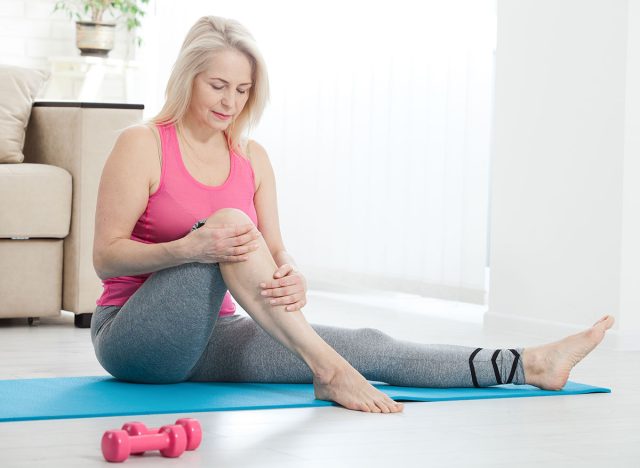Joint pain isn’t just a part of getting older—it can often be the result of exercise habits that are doing more harm than good. If you’re over 50 and trying to stay fit, you need to pay attention to how your workouts affect your joints. The focus keyword “exercise habits that are destroying your joints after 50” is essential because most people don’t realize that their daily moves could be causing long-term damage.
Whether you’re a gym-goer or someone who enjoys long walks, these five common habits could be quietly wearing your joints down. The good news? You can fix them before it’s too late.
Are You Ignoring Warm-Ups and Cool-Downs?
Skipping a proper warm-up is one of the worst habits you can develop. It’s especially risky after 50 when your joints need more care to stay mobile and pain-free.
When you don’t warm up, your muscles stay tight and your joints remain stiff. This increases your chance of injuries like tendon strains and joint inflammation. A good warm-up boosts circulation and lubricates the joints so they can move more smoothly.
Just as important is cooling down after your workout. It helps your joints recover and prevents stiffness later in the day. Stretching your major joints—hips, knees, shoulders—after a session supports flexibility and reduces post-workout tightness.
Are You Still Lifting Like You’re 25?
Heavy lifting might feel like a badge of honor, but it can be a ticket to joint damage if you’re not careful. After 50, your cartilage thins and your joints don’t absorb shock as well as they used to.
Doing high-impact lifts like deep squats with too much weight can grind your knees. Overhead presses can strain your shoulders and elbows. If your form slips even slightly, the pressure goes straight to your joints instead of your muscles.
Instead of pushing for heavy reps, focus on:
- Controlled movements
- Moderate weights
- Higher reps
- Joint-friendly tools like resistance bands or machines
Strength training is still important, but your technique and load need to match your age and mobility.
Are You Overdoing High-Impact Cardio?
Running on pavement, jumping jacks, and burpees are great for heart health, but they come at a price. Repetitive pounding can wear down your knee cartilage and ankle joints, especially as cushioning reduces with age.
Many people assume cardio is good in any form. But high-impact exercises can lead to micro-tears and inflammation that gradually build into bigger joint issues.
You don’t have to ditch cardio. Just swap it for joint-friendly options like:
- Walking on soft surfaces
- Elliptical training
- Swimming
- Stationary biking
These protect your knees and hips while still helping you burn calories and improve endurance.
Are You Exercising Through Joint Pain?
It might seem tough to take a break, but ignoring pain is a dangerous habit—especially joint pain. Pain is your body’s way of saying something’s wrong.
Exercising through discomfort, especially in your knees, shoulders, or lower back, can lead to chronic issues like arthritis or tendonitis. Many people over 50 believe they just have to “push through” but that often causes more damage.
If you feel sharp, persistent, or worsening joint pain, stop and reevaluate. You may need to:
- Adjust your workout plan
- Modify your range of motion
- See a physical therapist or orthopedic expert
Listening to your body can save your joints in the long run.
Are You Neglecting Mobility and Flexibility Training?
One of the most overlooked exercise habits that are destroying your joints after 50 is skipping mobility and flexibility training. It may not feel like a “real” workout, but it’s essential.
Joints are surrounded by muscles, tendons, and ligaments that need regular stretching and mobility exercises. Without it, your range of motion decreases and your joints become more prone to injury from basic movements.
Include these activities in your weekly routine:
- Yoga or gentle stretching
- Foam rolling
- Balance drills
- Dynamic mobility movements like hip openers or shoulder circles
Improving mobility helps your joints function properly and keeps your body aligned.
Safe vs Harmful Joint Exercise Habits After 50
| Harmful Habit | Safer Alternative |
|---|---|
| Skipping warm-ups | 5–10 minutes of dynamic stretches |
| Lifting too heavy | Moderate weights with good form |
| High-impact cardio | Low-impact aerobic options |
| Ignoring joint pain | Modifying or pausing the activity |
| Skipping mobility exercises | Adding stretching/yoga twice a week |
FAQs About Joint-Safe Exercise After 50
How can I tell if an exercise is hurting my joints?
If you experience sharp pain, swelling, or limited range of motion during or after a workout, that’s a red flag. It’s not normal soreness—your joints may be inflamed or strained.
What’s the best type of exercise for joint health?
Low-impact workouts like swimming, walking, Pilates, and resistance band training are excellent. They help strengthen muscles without putting extra stress on the joints.
Can I still lift weights after 50?
Yes, but you need to focus on form, avoid maxing out, and choose joint-friendly alternatives. Always prioritize safety over ego.
Is stretching really that important after 50?
Absolutely. Stretching improves flexibility, prevents joint stiffness, and supports long-term mobility. It’s just as important as strength and cardio.
How often should I work on mobility?
At least two to three times per week. Even 10–15 minutes a session can make a big difference over time.
Final Thoughts
You don’t need to stop exercising after 50—in fact, staying active is one of the best ways to stay healthy. But your approach needs to evolve. The same exercise habits that kept you fit at 30 can quietly damage your joints in your 50s and beyond.
Being aware of these five common exercise habits that are destroying your joints after 50 will help you train smarter. With a few changes, you can stay strong, mobile, and pain-free for years to come.










